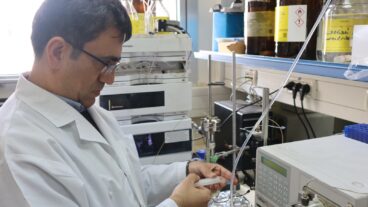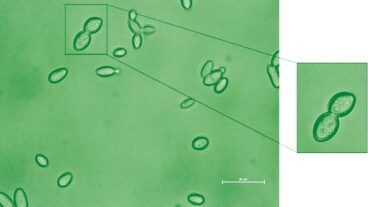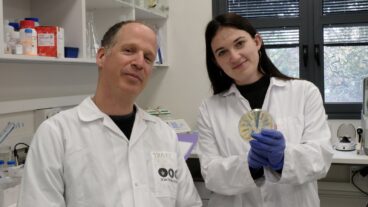At a neuromuscular junction in myasthenia gravis, there are fewer than the usual number of acetylcholine receptors on the muscle cell. An Israeli company is in the advanced stages of developing an effective treatment for Myasthenia Gravis (MG).
MG is a chronic and debilitating disease, which affects about 100,000 people worldwide, characterized by muscle weakness especially inability to open one’s eyes, and hand and leg muscle problems. The body’s immune system attacks acetylcholine receptors at the neuromuscular junction, interfering with normal muscular function. In severe cases the disease can involve the respiratory muscles, causing potentially life-threatening respiratory failure.
Ester Neurosciences, based in Herzliya, has recently completed a successful Phase Ib trial for its drug Monarsen – an orally-administered anti-sense therapy for the neurological disease. As a result, The U.S. Food and Drug Administration has granted Orphan Drug Designation status for Monarsen, (formerly known as EN101).
“Obtaining orphan drug designation marks an important step in our regulatory strategy for Monarsen,” said Dr. Eli Hazum, CEO of Ester Neurosciences. “Current MG treatments which include anti-cholinesterases, steroids and immunosuppressants, offer limited efficacy and often cause unpleasant and sometimes dangerous side effects. Monarsen offers the prospect of an efficacious and safe product that can address a very large market,” added Hazum.
Orphan drug designation is granted by the FDA for treatments that might provide significant benefit to patients with serious, life-threatening diseases that affect less than 200,000 persons in the United States. The Orphan Drug Act was created by Congress to provide assistance and incentives for sponsors to develop drugs judged to be of potential benefit for a qualifying disease.
Orphan Drug Designation status gives Ester, upon marketing approval, the exclusive right to market a drug of this kind for MG in the US for seven years. In addition to marketing exclusivity, the advantages of the designation include eligibility for research grants to conduct clinical trials, certain tax benefits, and an exemption from certain user fees at the time of submission for marketing approval of a new drug application. A similar Orphan Drug application has been made to European regulatory authorities.
The prevalence of myasthenia gravis in the United States is estimated at 14/100,000 population, approximately 36,000 cases in the United States. However, myasthenia gravis is probably under diagnosed and the prevalence is probably higher. Previous studies showed that women are more often affected than men. The most common age at onset is the second and third decades in women and the seventh and eighth decades in men. As the population ages, the average age at onset has increased correspondingly, and now males are more often affected than females, and the onset of symptoms is usually after age 50.
Ester’s Phase Ib results for Monarsen were presented at a special session of the National Academy of Neurology earlier this year. The breakthrough study was the first demonstration of the safe and effective use of an orally-administered anti-sense therapy for a neurological disease.
This study, where sixteen patients received oral liquid Monarsen, demonstrated significant improvement in MG symptom severity, with no cholinergic effects, nor significant adverse events. Fourteen out of sixteen patients had better scores on the Quantitative Myasthenia Gravis (QMG) scale on the last day of dosing as compared to the initial baseline. Improvement of total QMG score for these days ranged from 27.8% to 53.4% (p less than 0.01). The Phase Ib trial results showed that Monarsen appears to have superior efficacy, longer duration of action and a more favorable side effects profile than currently used medications. Patient recruitment for extended clinical trials with Monarsen is underway.
Neurologist Jon Sussman, lead investigator at the Greater Manchester Neuroscience Centre, a UK trial site told Bio World, “We were very impressed with the striking improvement in the condition of our patients. Monarsen even enabled some patients with limited mobility to regain their ability to stand and to walk without aids.”
The current means for treating MG is mainly a drug called Mestinon. While Mestinon is effective it deals only with symptoms of the disease and it has a short span of effectiveness. Mestinon works for only about two hours which means it must be administered up to six times a day by injection. It also has side affects such as diarrhea.
Monarsen on the other hand, is an antisense drug and works completely differently. Antisense technology was first developed about 10 years ago but first generation drugs started coming out only about four years ago. Monarsen is a third generation antisense drug and the first able to be administered orally instead of injected into the vein.
Antisense drugs have better penetration of the blood-brain barrier which many conventional drugs find difficult to cross. Thanks to its antisense technology, Monarsen need be administered only once a day, is more effective than Mestinon and has no known side affects.
According to Hazum, the same technology used in Monarsen can eventually be used to treat much more widespread diseases like Alzheimers and Multiple Sclerosis (MS). The company chose to target MG at first, because in US, drug markets of less than 100,000 potential patients, companies get exclusivity and the approval time is faster.
In addition, Alzheimers and MS are more complicated diseases which require testing on thousands of patients requiring tens of millions of dollars. In addition, approval takes longer – in this case up to three years more. Ester decided to initially target their concept on treating MG and then eventually partner with bigger companies for Alzheimers and other more widespread diseases.
“The next step is the Phase II study which we’re preparing for, in which we’ll compare head to head the efficiacy of Monarsen versus Mestinon. The studies will likely be held in the U.S. and Europe beginning at the end of the first quarter of 2004,” Hazum told ISRAEL21c. According to Hazum, if testing continues to go well in the second and third phases the drug could be ready for market by 2005
Monarsen is based on pioneering research carried out by Prof. Hermona Soreq of the Hebrew University. Ester Neurosciences was established in 1997 by Medica Venture Partners, to commercialize discoveries pioneered by Soreq, who is the company’s Chief Scientific Advisor.












